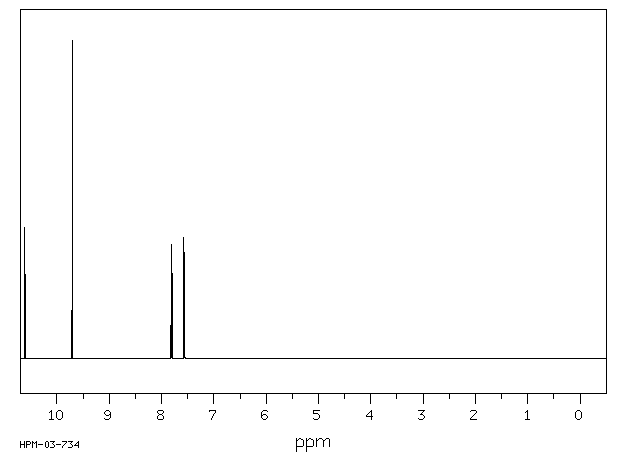3-甲酰基噻吩-2-羧酸 | 19991-68-5
中文名称
3-甲酰基噻吩-2-羧酸
中文别名
——
英文名称
3-formyl-thiophene-2-carboxylic acid
英文别名
3-carboxaldehyde-2-thiophene carboxylic acid;3-Formyl-2-thiophenecarboxylic acid;3-formylthiophene-2-carboxylic acid
CAS
19991-68-5
化学式
C6H4O3S
mdl
MFCD11052549
分子量
156.162
InChiKey
RUNMORKVPCSMTK-UHFFFAOYSA-N
BEILSTEIN
——
EINECS
——
-
物化性质
-
计算性质
-
ADMET
-
安全信息
-
SDS
-
制备方法与用途
-
上下游信息
-
文献信息
-
表征谱图
-
同类化合物
-
相关功能分类
-
相关结构分类
物化性质
-
熔点:130-131℃ (benzene ligroine )
-
沸点:344.8±27.0 °C(Predicted)
-
密度:1.514±0.06 g/cm3(Predicted)
计算性质
-
辛醇/水分配系数(LogP):0.9
-
重原子数:10
-
可旋转键数:2
-
环数:1.0
-
sp3杂化的碳原子比例:0.0
-
拓扑面积:82.6
-
氢给体数:1
-
氢受体数:4
安全信息
-
海关编码:2934999090
SDS
上下游信息
反应信息
-
作为反应物:描述:参考文献:名称:Psychotropic heterobicycloalkylpiperazine derivatives摘要:具有结构##STR1##的一系列具有精神药物异杂二环烷基哌嗪衍生物,其中V是一个3-或4-成员的不饱和链,当为4-成员时,含有所有碳原子,或者当为3-成员链时,V包含一个氧或硫原子作为其中之一;R是H或C.sub.1-4烷基;W是CH、N、CH.sub.2或一个化学键;X是CH、N、SO.sub.2或CO,但W和X不能同时为N;Z是一个杂芳环系统。这些化合物是有用的抗精神病和/或抗焦虑药物。公开号:US05001130A1
-
作为产物:描述:参考文献:名称:Carpenter, Andrew J.; Chadwick, Derek J., Journal of the Chemical Society. Perkin transactions I, 1985, p. 173 - 182摘要:DOI:
文献信息
-
Phosphorylamides, their preparation and use申请人:Takeda Chemical Industries, Ltd.公开号:US05840917A1公开(公告)日:1998-11-24A phosphorylamide derivative represented by the general formula (I): ##STR1## wherein R represents an amino group that may be substituted, or a salt thereof, possesses potent antibacterial activity against Helicobacter bacterium, especially Helicobacter pylori, and is useful for prevention or treatment of digestive diseases caused by Helicobacter bacterium, solely or in combination with an antacid or an acid secretion inhibitor.
-
Thienyl substituted acylguanidines as inhibitors of bone resorption and vitronectin receptor antagonists申请人:Aventis Pharma Deutschland GmbH and Genentech, Inc.公开号:US20030153557A1公开(公告)日:2003-08-14The present invention relates to thienyl substituted acylguanidine derivatives, such as compounds of formula (I) in which R 1 , R 2 , R 4 , R 6 , A, B and D have the meanings indicated in the claims, their physiologically tolerable salts and their prodrugs. The compounds of the present invention are valuable pharmaceutical active compounds. They are vitronectin receptor antagonists and inhibitors of bone resorption by osteoclasts. They are suitable, for example, for the therapy and prophylaxis of diseases which are caused at least partially by an undesired extent of bone resorption, for example of osteoporosis. The invention furthermore relates to processes for the preparation of thienyl substituted acylguanidines, their use, in particular as active ingredients in pharmaceuticals, and pharmaceutical preparations comprising them.
-
Novel microorganism and its use in lignocellulose detoxifixcation申请人:Shell Internationale Research Maatschappij B.V.公开号:EP2308959A1公开(公告)日:2011-04-13The present invention relates to an isolated microorganism which is Cupriavidus basilensis strain HMF14 Deposit number DSM 22875, and its use in a process for the in-situ detoxification of lignocelluloses hydrolysate
-
Robba,M. et al., Bulletin de la Societe Chimique de France, 1967, p. 2495 - 2507作者:Robba,M. et al.DOI:——日期:——
-
Ring-Chain Tautomerism in 2-(2,2-Dicyano-1-methylethenyl)benzoic Acid and Related Compounds.作者:Per Kolsaker、Joe Arukwe、József Barcóczy、Are Wiberg、Anne Kristine Fagerli、Ole Hammerich、Inger Søtofte、Bengt LångströmDOI:10.3891/acta.chem.scand.52-0490日期:——Ring-chain tautomerism with slow interconversion (compared with the NMR timescale) was observed in solutions of 2-(2,2-dicyano-1-methylethenyl)benzoic acid (3e), obtained by Knoevenagel condensation of 2-acetylbenzoic acid with malononitrile, forming the ring tautomer 3-dicyanomethyl-3-methylphthalide (4e) in admixture with 3e. Similar condensations of 2-formylbenzoic acid with methyl cyanoacetate or malononitrile give 2-(2-cyano-2-methoxycarbonyl-ethenyl)benzoic acid (3b) and 2-(2,2-dicyanoethenyl)benzoic acid (3d), respectively, which in solution also exhibit the same tautomerism to give the ring tautomers, 3-(cyanomethoxycarbonylmethyl)phthalide (4d) and 3-(dicyanomethyl)phthalide (4d), respectively. Condensation of 2-formylbenzoic acid with dimethyl malonate gave only the ring compound, 3-(dimethoxycarbonylmethyl)phthalide (4a). Attempts to synthezise 2-(2-cyano-2-methoxycarbonyl-1-methylethenyl)benzoic acid (3c) by methylation of the trimethyl silylester of 3b with diazomethane led to the ring form of 3c, viz. 3-cyanomethoxycarbonylmethyl-3-methylphthalide (4c) as an equimolar mixture of two diastereomers. No tautomerism was observed when the benzene ring was replaced by a thiophene ring (7a, 7b and 8) or an aliphatic double bond (9). Solid state spectra (IR and NMR) indicated that all compounds carrying two cyano groups at the double bond, except the aliphatic compound 9, were in the open-chain form, while all the others were in the ring form. Equilibrium studies for compound (3e reversible arrow 4e) indicated increased stability for the chain form 4e with increasing solvent polarity. Determination of the free energy change, Delta G degrees, and of the free energy of activation, Delta G(double dagger), for the tautomerization in deuteriochloroform (using H-1 NMR spectroscopy) indicated that, in this solvent, a concerted process from the starting material 3e to the anion of 4e is taking place. It is also postulated that a similar reaction path is followed in the other solvents used in this investigation, all belonging to the solvent class 'protophobic dipolar aprotic solvents'.
表征谱图
-
氢谱1HNMR
-
质谱MS
-
碳谱13CNMR
-
红外IR
-
拉曼Raman
-
峰位数据
-
峰位匹配
-
表征信息
同类化合物
阿罗洛尔
阿替卡因
阿克兰酯
锡烷,(5-己基-2-噻吩基)三甲基-
邻氨基噻吩(2盐酸)
辛基5-(1,3-二氧戊环-2-基)-2-噻吩羧酸酯
辛基4,6-二溴噻吩并[3,4-b]噻吩-2-羧酸酯
辛基2-甲基异巴豆酸酯
血管紧张素IIAT2受体激动剂
葡聚糖凝胶LH-20
苯螨噻
苯并[c]噻吩-1-羧酸,5-溴-4,5,6,7-四氢-3-(甲硫基)-4-羰基-,乙基酯
苯并[b]噻吩-2-胺
苯并[b]噻吩-2-胺
苯基-[5-(4,4,5,5-四甲基-[1,3,2]二氧杂硼烷-2-基)-噻吩-2-基亚甲基]-胺
苯基-(5-氯噻吩-2-基)甲醇
苯乙酸,-α--[(1-羰基-2-丙烯-1-基)氨基]-
苯乙酰胺,3,5-二氨基-a-羟基-2,4,6-三碘-
苯乙脒,2,6-二氯-a-羟基-
腈氨噻唑
聚(3-丁基噻吩-2,5-二基),REGIOREGULAR
硝呋肼
硅烷,(3-己基-2,5-噻吩二基)二[三甲基-
硅噻菌胺
盐酸阿罗洛尔
盐酸阿罗洛尔
盐酸多佐胺
甲酮,[5-(1-环己烯-1-基)-4-(2-噻嗯基)-1H-吡咯-3-基]-2-噻嗯基-
甲基5-甲酰基-4-甲基-2-噻吩羧酸酯
甲基5-乙氧基-3-羟基-2-噻吩羧酸酯
甲基5-乙基-3-肼基-2-噻吩羧酸酯
甲基5-(氯甲酰基)-2-噻吩羧酸酯
甲基5-(氯乙酰基)-2-噻吩羧酸酯
甲基5-(氨基甲基)噻吩-2-羧酸酯
甲基5-(4-甲氧基苯基)-2-噻吩羧酸酯
甲基5-(4-甲基苯基)-2-噻吩羧酸酯
甲基5-(1,3-二氧戊环-2-基)-2-噻吩羧酸酯
甲基4-硝基-2-噻吩羧酸酯
甲基4-氰基-5-(4,6-二氨基吡啶-2-基)偶氮-3-甲基噻吩-2-羧酸酯
甲基4-氨基-5-(甲硫基)-2-噻吩羧酸酯
甲基4-{[(2E)-2-(4-氰基苯亚甲基)肼基]磺酰}噻吩-3-羧酸酯
甲基4-(氯甲酰基)-3-噻吩羧酸酯
甲基4-(氨基磺酰基氨基)-3-噻吩羧酸酯
甲基3-甲酰氨基-4-甲基-2-噻吩羧酸酯
甲基3-氨基-5-异丙基-2-噻吩羧酸酯
甲基3-氨基-5-(4-溴苯基)-2-噻吩羧酸酯
甲基3-氨基-4-苯基-5-(三氟甲基)-2-噻吩羧酸酯
甲基3-氨基-4-氰基-5-甲基-2-噻吩羧酸酯
甲基3-氨基-4-丙基-2-噻吩羧酸酯
甲基3-[[(4-甲氧基苯基)亚甲基氨基]氨基磺酰基]噻吩-2-羧酸酯







